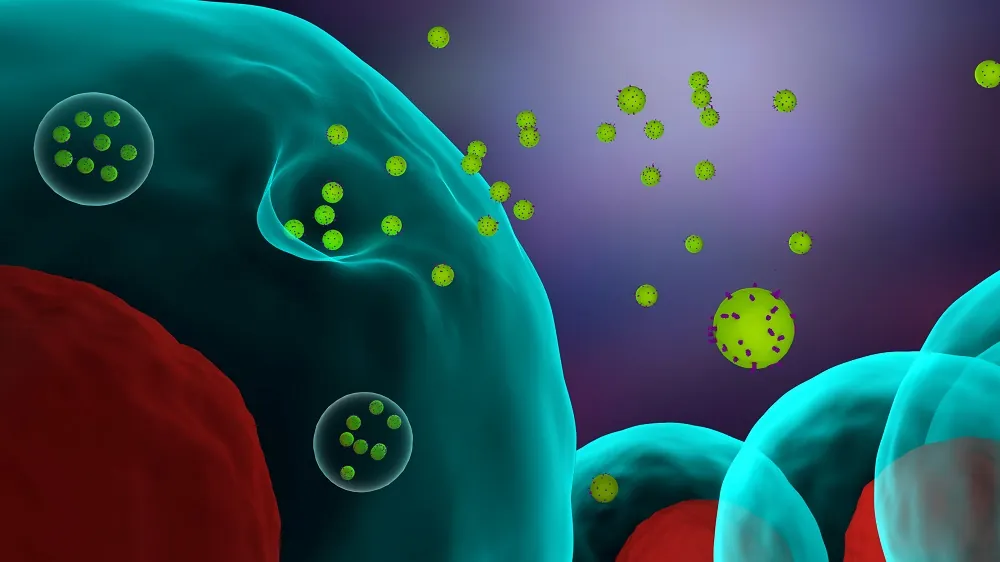In Metabolism Clinical & Experimental, researchers have described how the reduced isoform of the SASP factor HMGB1 causes senescence to spread.
An alarm that doesn’t turn off

Read More
HMGB1 is an alarmin protein, which, as its name suggests, is released as a response to damage, making it a damage-associated molecular pattern (DAMP). It is also part of the SASP and a key factor in the spread of inflammation [1]. Inside the nucleus, it regulates gene expression [2], but damaged cells release it into the extracellular space, where it is picked up by other cells’ receptors and can drive them senescent [3].
Secreted factors driving other cells senescent is known as paracrine senescence. Dr. Amit Sharma, Principal Investigator of the Sharma Lab at Lifespan Research Institute, noted that this kind of senescence is “one of the least understood senescence types.”
HMGB1 has three forms, which are distinguished by the oxidation-reduction (redox) state of the cysteine residues of this protein. The terminally oxidized form, OxHMGB1, is associated with both stress and inflammation but is not an inflammatory signaling molecule [4]. Its disulfide form, DsHMGB1, triggers the release of well-known infammatory factors such as IL-6 and TNF-α [2]. Its reduced form, ReHMGB1, the form in which it is secreted, is the form that binds to receptors such as RAGE to promote inflammation [5].
HMGB1 was previously determined to promote local inflammation and senescence [3], but that work did not determine the extent of any systemic effect. This paper, therefore, focuses on what it might be doing throughout the body, focusing on the different effects of its redox types.
ReHMGB1, but not OxHMGB1, drives senescence
In their first experiment, the researchers examined WI-38 lung fibroblasts, which are commonly used to study senesence. They cultivated these cells in a medium that was derived from cells driven senescent through ionizing radation, thus containing HMGB1 [2]. One group of these cells was also dosed with an antibody against HMGB1. Compared to control groups that received the HMGB1 but not the antibody, the antibody group had greater proliferation; less of the senescence biomarkers SA-β-gal, p21, and p53; and decreased SASP expression, including inflammatory cytokines. This antibody may have reduced the contagious spread of HMGB1-related senescence: the anti-HMGB1 treated group actually had more HMGB1 in their nuclei, which suggests that they excreted less of it into the medium.
The researchers then treated two groups of cells with ReHMGB1 and OxHMGB1. While the ReHMGB1 cells behaved as expected, displaying increased senescence according to multiple biomarkers along with decreased proliferation, the OxHMGB1 group did not change at all according to any of the metrics used. This discovery, which Dr. Sharma found to be surprising, was replicated in multiple cell types.
Substantial gene expression changes
The OxHMGB1 group of treated cells had no senescence-related upregulation of genes. Instead, its 619 changes compared to controls had different effects, including an increase in interferons and a diminishment of the senescence-related TGF-β signaling pathway. Any downstream effects that these changes might have induced were not found in this study.
In the ReHMGB1 group, there were 1,087 changes to gene expression compared to controls. Overall, these changes strongly promoted senescence, with key senescence-related pathways being activated in a very similar way to irradiation-induced senesence. A further pathway analysis confirmed these findings, identifying the molecular methods by which ReHMGB1 drives cells senescent, including a positive feedback mechanism that encourages the secretion of more ReHMGB1 [6]. According to Dr. Sharma, this study shows that “ReHMGB1, secreted by senescent cells, can induce senescence in neighboring and distant cells through the RAGE–NF-κB–JAK/STAT signaling axis, effectively propagating the senescent phenotype.”
ReHMGB1 spurs senescence in mice
These findings were replicated in mice. Unsurprisingly, 24-month-old mice have significantly more circulating ReHMGB1 than 3-month-old mice. This is also true of human serum samples; despite only having a non-significant trend in total HMGB1, 70- to 80-year-old people have significantly more ReHMGB1 than 40-year-olds.
Administering ReHMGB1 to 3-month-old mice increased markers of senescence one week after injection. Compared to controls, the mice given ReHMGB1 had significantly higher levels of the inflammatory cytokines IL-6 and IL1β. While most markers of inflammation were not increased in most tissues, ReHMGB1 induced an increase in the SASP factor TIMP1 along with the senescence biomarkers p16 and p21. Mirroring the in vitro study, administering ReHMGB1 actually decreased the amount of HMGB1 in the nuclei of these mice’s cells.
The researchers then investigated if it was possible to target HMGB1 in order to promote faster healing. A day before being injured by an injection of barium chloride, 15-month-old mice were given an anti-HMGB1 antibody. Compared to a group given only an injury, the anti-HMGB1 group had reduced senescence markers, better grip strength, and better performance in rotarod and treadmill tests.
While these findings are encouraging, further work will have to be done to determine whether or not targeting HMGB1 is effective in treating muscle injuries or age-related diseases in people. Dr. Sharma commented that “it would be interesting to see how SASP and DAMP are qualitatively or quantitatively different” and that “we are only beginning to understand the consequences of DAMPS in driving aging and inflammation; it does present attack vectors for novel, more selective therapeutic strategies to limit the spread of senescence and its deleterious effects.”
Literature
[1] Sofiadis, K., Josipovic, N., Nikolic, M., Kargapolova, Y., Übelmesser, N., Varamogianni‐Mamatsi, V., … & Papantonis, A. (2021). HMGB1 coordinates SASP‐related chromatin folding and RNA homeostasis on the path to senescence. Molecular systems biology, 17(6), e9760.
[2] Davalos, A. R., Kawahara, M., Malhotra, G. K., Schaum, N., Huang, J., Ved, U., … & Campisi, J. (2013). p53-dependent release of Alarmin HMGB1 is a central mediator of senescent phenotypes. Journal of Cell Biology, 201(4), 613-629.
[3] Venereau, E., Casalgrandi, M., Schiraldi, M., Antoine, D. J., Cattaneo, A., De Marchis, F., … & Bianchi, M. E. (2012). Mutually exclusive redox forms of HMGB1 promote cell recruitment or proinflammatory cytokine release. Journal of Experimental Medicine, 209(9), 1519-1528.
[4] Kwak, M. S., Kim, H. S., Lee, B., Kim, Y. H., Son, M., & Shin, J. S. (2020). Immunological significance of HMGB1 post-translational modification and redox biology. Frontiers in immunology, 11, 1189.
[5] Kim, S. Y., Son, M., Lee, S. E., Park, I. H., Kwak, M. S., Han, M., … & Shin, J. S. (2018). High-mobility group box 1-induced complement activation causes sterile inflammation. Frontiers in Immunology, 9, 705.
[6] Gacaferi, H., Mimpen, J. Y., Baldwin, M. J., Snelling, S. J., Nelissen, R. G., Carr, A. J., & Dakin, S. G. (2020). The potential roles of high mobility group box 1 (HMGB1) in musculoskeletal disease: A systematic review. Translational Sports Medicine, 3(6), 536-564.


